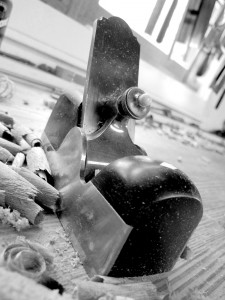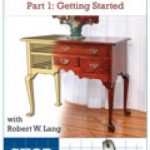We may receive a commission when you use our affiliate links. However, this does not impact our recommendations.
I have a palm-grip random-orbit sander that I’ve used for many years on household projects that could not be planed because they were too big, such as 16’-long runs of base moulding nailed to a wall, or weren’t designed for handplaning, such as plywood that is covered in paper-thin veneer.
A couple years ago, the pad on the sander disintegrated as I was sanding some paint on a moulding. I shrugged my shoulders, put the sander away and finished the job with a sanding block.
Until this week, I’d almost forgotten that I owned a broken sander.
Then I started planing the “roey” mahogany grain on the drawer fronts of this Campaign chest I’m building. What’s roey grain? It’s a figure in the wood that is caused by repeated cycles of spiral growth in a tree that reverse left and then right, according to Bruce Hoadley’s “Understanding Wood.”
Here’s how I visualize it: Spiral grain is where the fibers of the wood spiral up the tree, like the stripes on a barber pole. Spiral grain is bad enough when it occurs in a mild domestic tree. The result is the grain will run one way on one side of the board’s cathedral and the other way on the other side of the cathedral.
Roey grain is a whole circle of hell worse. In a tree with a bad case of roe, the grain wraps around the tree clockwise for a year, then wraps around counter clockwise the next, back and forth.
The result is that the wood has an attractive striped figure when light reflects off it. It also makes the wood difficult to handplane. It makes you remember broken sanders and – after a couple beers – order a replacement pad for your sander.
My replacement pad came yesterday. I installed it on the sander and then put the little blue beastie back in its deep drawer. Why? The handplane of last resort.
I think every woodworker has a tool that was meant for him or her. It could be a junker, an infill or something between. But it is the plane that doesn’t let you down. For me, that plane is a little infill smoother I purchased from Wayne Anderson in 2006.
As far as I know I’ve never measured the bedding angle of the iron or the throat opening. The angle is kinda high and the mouth is kinda tight. It is a small tool, about the same size as a block plane, and it fits my hands like it was made for me.
But most of all, I cannot remember this plane letting me down. It always seems to be able to plane curly, roey, interlocked, whatever grain. Why? Was it anointed with the balms of forbidden trees? Did Wayne sell his sole/soul to the devil? Don’t know. But I keep its iron sharp and trot it out when I get backed into a corner.
Sleep tight little sander. This is not your day.
— Christopher Schwarz
For a detailed discussion of tear-out and its remedies, see our book “Handplane Essentials,” which covers it in detail. It also discusses infills — their realities and myths. The book is available in ShopWoodworking.com.
Here are some supplies and tools we find essential in our everyday work around the shop. We may receive a commission from sales referred by our links; however, we have carefully selected these products for their usefulness and quality.










And since their are no prices listed on the Anderson website, I’m assuming that if I have to ask then I can’t afford it ! Chris have you seen a therapist about your plane addiction yet?
Chris, you should try planing almond. Its ROEY… sort of like planing a hawser rope.
Tom
Wait a minute. So…… you’re saying Mr. Schwarz *didn’t* opt to use a tool with a power cord when faced with some ‘roey’ grain????? OK, give a second, I’m trying to picture this. Nope! I just can’t imagine. :•) Plane ON dear sir!
i had some of this nasty grain on mahogany too. I didn’t have just one name for it though (although is this the same as “interlocked grain”?), just a whole string of expletives. I ended up sanding it.
Isn’t this really what a scraper plane is for, though?
I’d like to try one of those planes, it’s amazing to look at.
I’m assuming that the shavings in the picture didn’t come from that plane, right?
Yes. Those planes are awesome. It really does depend on the type of wood that you are trying to work with though.
This reminds me of a shipwright I met in Maine who called his angle grinder with the flap wheel “the Boothbay Harbor Block Plane”
I’ve checked out Anderson’s planes and they are beautiful. My problem is that nearly everything I’ve ever made has been because I’ve needed it. I’ve yet to make something because simpl for the fun of it, though I do enjoy the building process. That being said I cannot justify spending crazy dollars on a plane because it’s cool, no matter how cool it is. Therefore I use my smoothing plane and finish with a sanding block and random orbital sander. It may not be traditional but it works.
I’m all for doing certain things traditionally, that doesn’t mean that modern methods should be completely abandoned in my opinion.
Wood that’s easy to plain is seldom worth the effort .
Chris, I can understand you not wanting to examine the magic plane too closely. But you would do us all a great service if you could come up with some insight as to how the magic happens. Might stop Megan doing something rash, too.
Alas, I do not have such a plane. I have one that gets me close, then I pull out my # 80, and then a hand scraper (with a damp pad to keep my thumbs from burning). I love period furniture and gnarly mahogany, and can’t blame anyone for using a ROS.
Ah yes — the one I call the Magic Plane. It is the tool of yours I covet beyond all others. (Second is, of course, your Eccentric DT saw)